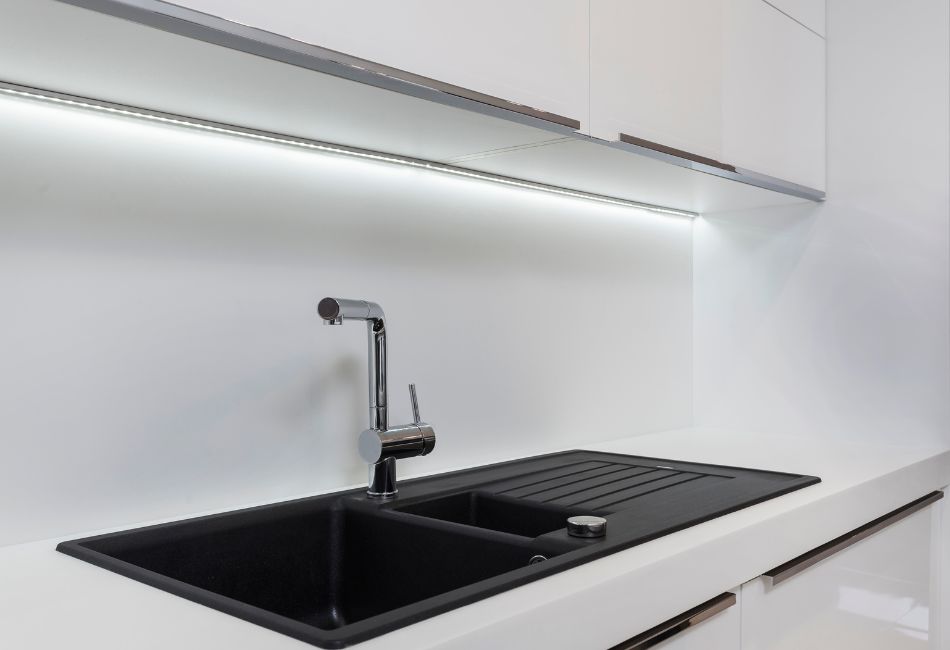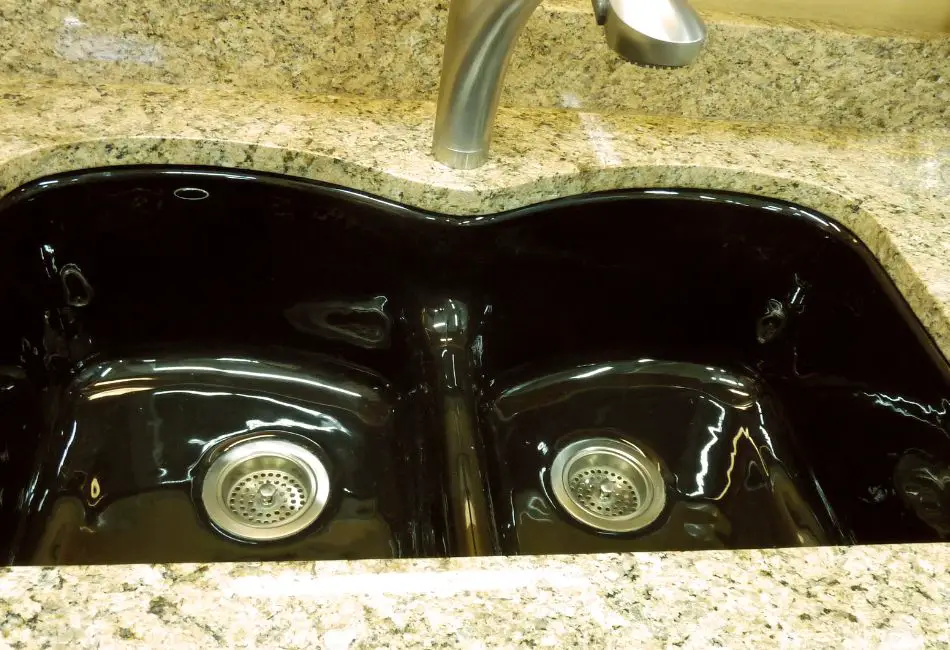When it comes to kitchen sinks, there are different types that you can choose from. Two of the most popular types are drop-in sinks and undermount sinks. Although both these types of sinks serve the same purpose, there are some key differences that you should be aware of. Both also have their own unique benefits and drawbacks, which this article will explore in detail.
What Is A Drop-In Sink?

As the name suggests, a drop-in sink otherwise called a self-rimming or top-mount sink is one that sits on top of your countertop. It is set into a countertop through a cutout. It is attached to the counter with adhesive or silicone caulk, and it typically has a lip around the edge that helps keep water from spilling onto the countertop.
Drop-in sinks come in a variety of sizes and shapes, making them a versatile option for many kitchens. They are also relatively affordable compared to other sink types.
Common Drop-In Sink Sizes
While there is no standard size for drop-in sinks, a few common sizes are typically used. The most common size is 22 inches by 25 inches, which provides ample space for washing dishes and other kitchen tasks.
The size of a rectangular drop-in sink, for instance, can averagely measure 24 inches in length, 18 inches in width, and 5 inches in height or water depth.
Other common sizes include 26 inches by 22 inches. Drop-in sinks can also be custom-made to fit any size countertop.
What is An Undermount sink?

As the name suggests, an undermount sink is one that is bolted to the bottom of the countertop, and they provide a seamless transition from countertop to sink. It is attached to the underside of the counter with heavy-duty clips or brackets and it doesn’t have a lip that extends over the edge of the countertop. The rim of the sink rests up against the bottom of the countertop, i.e, it is hidden by the base of the counter.
Common Undermount Sink Sizes
Just like the drop-in sink, there is no standard size for undermount sinks, as they are designed to be installed beneath a countertop. The size of the sink will therefore be determined by the size of the countertop cutout. However, there are some common widths and depths that are used for undermount sinks.
The most common widths are 24 inches, 30 inches, and 36 inches. As for depth, undermount sinks typically range from 6 to 10 inches deep. Of course, there are also smaller and larger sizes available, so it is important to choose a sink that will fit the space you have available.
Factors to Consider When Choosing a Drop-In Sink or an Undermount Sink
1. Style And Preference
Drop-in sinks come in a wide range of styles, from traditional to modern, so you’re sure to find one that fits your kitchen. Undermount sinks tend to have a more timeless look, which can be both good and bad depending on your personal taste.
2. Cost Implication
Another factor you should consider when buying a drop-in or undermount sink is the price. Arguably, the cost of the sink will depend on factors such as the material and sink size. The actual cost comes with the installation. The cost of installing an undermount sink is a bit higher than drop-in Therefore, whichever you decide to choose may also be largely dependent on how much money you are willing to part ways with to get the sink.
3. Ease Of Installation
How easy or otherwise, it may be to fix a sink may be one of the reasons to consider when choosing a drop-in or undermount sink.
Drop-in sinks are much easier to install since you don’t need to remove the countertop. If you are confident in your DIY skills, you can install a drop-in sink yourself.
On the other hand, undermount sinks require more work to install since they need to be attached to the underside of the countertop, but they offer a cleaner look since there’s no lip around the edge of the sink. As such, it is advisable to hire a professional to install an undermount sink to avoid any damage to your counter
4. Countertop Compatibility
When it comes to choosing between a drop-in and an undermount sink, the type of countertop should be taken into consideration. While you are not limited when it comes to countertops with regard to drop-in sinks, there are some countertop material restrictions when it comes to installing an undermount sink.
If you have a natural stone countertop, an undermount sink is the best option to show off the beauty of the material. However, if your countertop is made of laminate or another man-made material, a drop-in sink may be a better choice.
5. Cleaning And Maintenance
I would want to believe that if you are one that is concerned about the maintenance of a sink, you may want to consider how easy or difficult it is to clean the sink when choosing one.
Drop-in sinks are easier to clean because all cleaning areas of the sink are visible and accessible. The visible seam formed between the lip and countertop can still harbor dirt and build-up, but this is much easier to clean than the space between an undermount sink and countertop because it is visible.
Cleaning an undermount sink is also easy, but reaching the space between the rim and the countertop can be difficult if not impossible. Although this space is usually filled with silicone caulk, it can still be a breeding ground for bacteria because when depression forms, water and particles can become trapped.
Similarities Between A Drop-In Sink And An Undermount Sink
- Functionality: Whether a drop-in or undermount sink, the function of the sink does not change. This is one similarity between drop-in and undermount sinks. Ultimately, a sink is for some form of washing, whether hands, utensils, or food items, both deliver on that function.
- Shape and size: Drop-in and undermount sinks come in various shapes and sizes. Both types come in rectangular, square, oval, and circular shapes. So, shape and size are common denominators in drop-in and undermount sinks.
Differences Between A drop-In Sink And An Undermount Sink
- Installation: The major difference between a drop-in sink and an undermount sink is the visibility or otherwise of the rim of the sink. An undermount sink is fitted below the sink, as such, the rim is hidden. On the other hand, a drop-in sink is installed above the counter and as such, the rim can be seen. Moreover, it may be easier to install a drop-in sink as compared to an undermount sink.
- Cost: As stated earlier, undermount sinks are generally more expensive than drop-in sinks in both price and installation. Though the price difference may be marginal sometimes, it is still noticeable.
Pros of Drop-In Sinks
1. They Are Easy To Install
Drop-in sinks are easy to install because they sit on top of the countertop. This means that you do not have to drill any holes in the countertop in order to install it. It doesn’t;t require as much work or expertise to install. Their installation can even be a DIY if you are up to the task.
2. They Are Versatile
Drop-in sinks are versatile because they can be used in almost any kitchen and works with all types of countertops. Additionally, drop-in sinks are available in a variety of shapes and sizes, so you can find one that will fit your specific needs.
3. They’re Easy To Clean
One of the main benefits of drop-in sinks is that they are easy to clean. Since they sit on top of the countertop, all you have to do is wipe them down with a damp cloth. Any dirt will be easily visible for you to clean. There are no nooks or crannies for dirt and grime to hide without you seeing.
4. They’re Budget Friendly
Drop-in sinks are relatively cheaper as compared to undermount sinks. Therefore if you do not want to go too hard on your pocket, then, a drop-in sink is the way to go.
Cons Of Drop-In Sinks
1. Less Counter Space
I know you may think it is just about 2 or 3 inches but if you have limited counter space, a drop-in sink should not be your choice. This is because the perimeter of the sink will take away a few more inches from your remaining already limited counter space.
2. Less Streamlined Look
Drop-in sinks may not be the best option if you are looking for a sleek and streamlined look in your kitchen. Because they sit on top of the countertop, the edge of the sink will be visible. This can disrupt the flow of your countertop.
3. Adds Barrier When Cleaning
Although visible areas are easy to clean, they pose difficulties when cleaning the countertop. If there are food particles on the countertop, you cannot easily wipe them into the sink without them getting stuck on the edge first which can be frustrating.
4. Requires Durable Countertops
To install a drop-in sink, your counter must be heavy and durable as it would give support to the weight of the sink. You are however not restricted in the type of material your countertop should be made from.
Pros of Undermount Sinks
1. More Counter Space
Even if it is a few inches, undermount sinks give you more counter space as they are fitted from beneath the counter top and the rim of the sink is not visible. They do not take up as much counter space as a traditional sink.
2. Sleek, Modern Look
Undermount sinks are sleek and modern looking as they do not have any visible rim. This gives a much cleaner and streamlined look to your kitchen.
3. Easy To Clean The Countertop
They are easier to keep clean because the countertop and sink are one seamless surface. If there are some particles on the countertop, you can just push them into the sink and clean up. You do not have to worry about them getting stuck around the seam between the rim and the countertop as it would have happened if you were using a drop-in sink.
Cons Of Undermount Sinks
1. Require More Support
Undermount sinks require more support to remain sturdy. Unlike drop-in sinks which are supported by the countertop, undermount sinks need to be supported beneath with clips and brackets. If not done properly, the sink can drop and break.
2. More Difficult To Install
Undermount sinks are more difficult to install so you are more likely to need professional hands in fixing them. Installing an undermount sink is not recommended as a DIY project because it can be quite tricky and challenging.
3. Not Suitable For All Countertops
They are not suitable to be used with all types of countertops. Only use them with countertops that are thick and strong enough to support the sink. For example, using an undermount sink with laminate countertops is not recommended as they are not strong enough to support the weight of the sink. They are suitable for countertop materials such as granite, marble, or solid surface.
4. More Expensive
Undermount sinks are more expensive than drop-in sinks because they come with all the necessary brackets and clips required for installation. They also require professional installation which can add to the overall cost.
5. Traps Dirt and Dust
Because they are fitted beneath the countertop, undermount sinks can be difficult to clean. Any dirt or dust that gets trapped beneath the countertop can be hard to reach and clean. This can lead to the build-up of dirt and grime over time.

